Boost your gaming with Nvidia
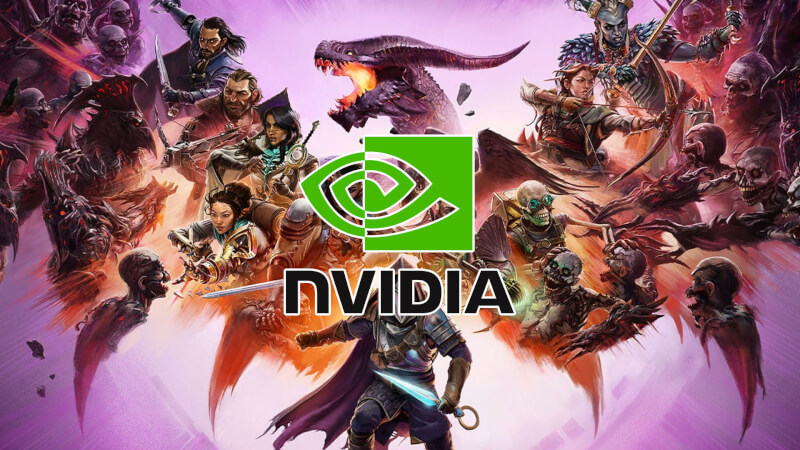
In addition to the pure performance that modern graphics cards bring to the table, one of the new developments is software solutions that, using AI and Machine Learning, among other things, can help boost our Frame Rates.
Today we're taking a look at the possibilities with the modern Nvidia graphics cards in the RTX 40 series. Specifically, I'm taking a look at DLSS 3, which is a fixed part of all cards in the RTX 40 series. To test it, I have a gaming laptop with an RTX 4070 graphics card, and I'm looking at how much of a boost I can get from using technologies like DLSS.
What is Nvidia DLSS?
DLSS (Deep Learning Super Sampling) has gone through a few generations and Nvidia announced DLSS as a key feature in the GeForce 20-series graphics cards at their launch in September 2018. So it's been a while since DLSS saw the light of day.
In short, DLSS in its basic form works through DLSS Super Resolution, which increases the performance of all GeForce RTX GPUs by using AI to produce higher-resolution images from lower-resolution inputs. DLSS combines multiple lower-resolution images and uses motion data and feedback from previous images to recreate images at their original quality.
The result should be that players can experience higher frame rates at higher resolutions than their graphics card would normally be able to handle without the help of DLSS.
However, it has been a question of finding a balance, as DLSS typically comes with a degree of visual degradation in the image, compared to running at full resolution.
DLSS 3.5
However, a lot has happened since the first versions of Nvidia DLSS and the latest version, DLSS 3.5, which came with the RTX 40 series of graphics cards, is a clear improvement over previous versions.
Partly, the hardware in the RTX 40 series has improved with the dedicated Tensor Cores used for DLSS. The underlying software solutions and algorithms have of course also improved. It's no secret that AI has gotten a huge boost over the past few years. It's a development that is largely driven by chips from Nvidia.
Fortunately, these advances can also be felt in DLSS, which has become much better.
The new additions in DLSS 3.5 are improvements to Super Resolution and Deep Learning Anti-aliasing, and the advancements here can be enjoyed across all GeForce RTX graphics cards.
On top of that, however, there have been features such as Frame Generation and Ray Reconstruction, which can only be used on the new RTX 40 series cards.
So if you have an RTX 400 series card, you can enjoy these technologies as part of DLSS 3.5 in supported games:
- DLSS Super Resolution: Boosts performance on all GeForce RTX GPUs by using AI to produce higher-resolution images from lower-resolution inputs. DLSS combines multiple lower-resolution images and uses motion data and feedback from previous images to recreate images at their original quality.
- Deep Learning Anti-aliasing: Delivers higher image quality for all GeForce RTX GPUs with an AI-based anti-aliasing technique. DLAA uses the same Super Resolution technology developed for DLSS and restores images at their original resolution to maximize image quality.
- DLSS Frame Generation: Boosts performance by using AI to generate more frames while maintaining excellent responsiveness with NVIDIA Reflex. DLSS analyzes sequential frames and motion data from the new Optical Flow Accelerator in GeForce RTX 40-series GPUs to create additional high-quality frames.
- DLSS Ray Reconstruction: Improves image quality on all GeForce RTX GPUs by using AI to generate extra pixels in intensive ray tracing scenes. DLSS replaces manually adjusted denoisers with an NVIDIA supercomputer-trained AI network that generates higher-quality pixels between the sampled rays.
- NVIDIA Reflex: NVIDIA Reflex, GeForce RTX 40-series GPUs and G-SYNC® displays deliver the lowest latency and best responsiveness for the ultimate competitive advantage. Designed to optimize and measure system latency, Reflex delivers faster target acquisition, faster response times, and the best aiming accuracy for competitive gaming.
Practical test
To see how much there is to gain with DLSS 3.5, I take a look at a Lenovo Legion gaming laptop and test with the game Dragon Age - The Veilguard.
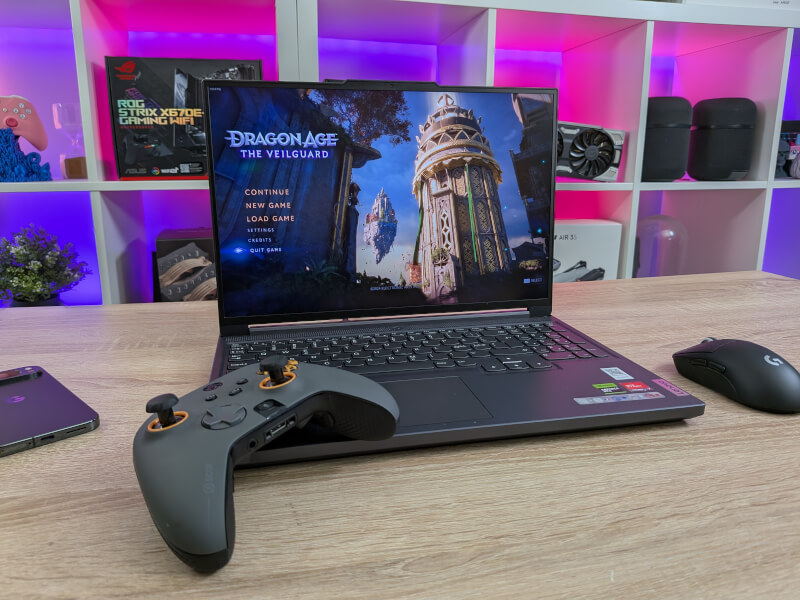
It's a brand new game title, which of course comes with DLSS support.
The Lenovo Legion system that I use has the following hardware:
- CPU: Ryzen 7 7840HS
- RAM: 16GB RAM
- GPU: Nvidia RTX 4070
- Display: 2560x1600 at 165 Hz
Overall, a solid collection of hardware for gaming, but since we also have a screen with a fairly high resolution, new games can still be a challenge.
First test WITHOUT DLSS
I started by launching Dragon Age - The Veilguard at the system's native resolution of 2560x1600, without any form of DLSS or other Super Resolution technologies. I tested three levels of graphical presets, Low, Medium, and High.
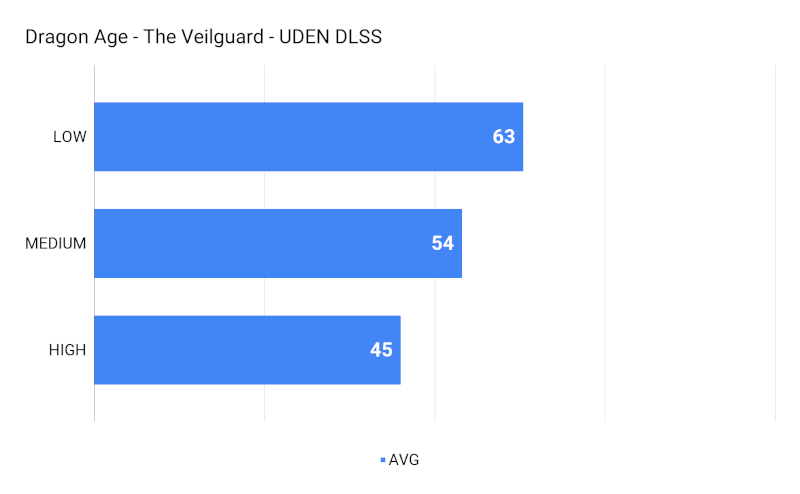
Here we can see that the results on low were already very close to the magical 60 FPS that many PC gamers like to see as a minimum. With FPS results of 63 FPS on the Low Preset, we are certainly very far from being able to enjoy the 165 Hz that the screen on the Lenovo Legion laptop can handle.
Second test with DLSS
In the next attempt, I ran a test with DLSS set to Balanced. The DLSS setting was set to Balanced to get a good balance between performance and graphics quality. However, I didn't turn on Frame Generation to get an idea of what improvement you can get via DLSS alone if you don't have one of the newer RTX 40 series cards that can utilize Frame Generation.
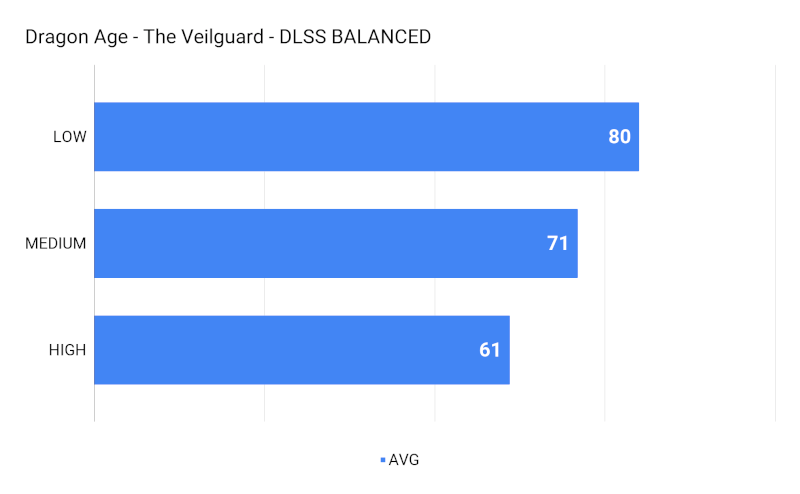
Here we can see that even with DLSS alone we can enjoy a solid boost to FPS results with DLSS set to Balanced. We are now on the good side of 60 FPS even on the High Preset while Medium and Low are doing reasonably well above 60 FPS.
Third test WITH DLSS and Frame Generation
From here I went on to test the same three graphics presets, Low, Medium and High. This time, however, with DLSS and Frame Generation turned on. Here we can see the full benefits that Nvidia technologies offer.
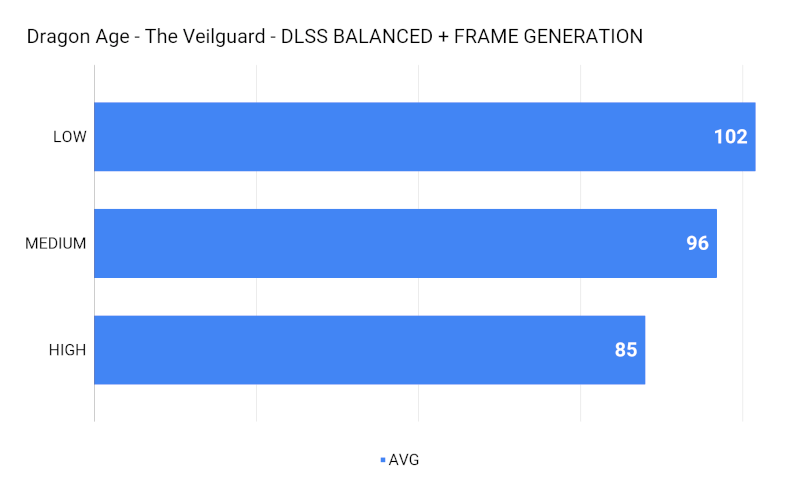
The experience of the game was completely different, and it can be clearly seen in the FPS results that DLSS and Frame Generation are changing things. Low and Medium settings came in with results close to 100 FPS, while even on the High Preset setting I saw FPS results in the mid 80s.
All of this could be done without me seeing any immediate deterioration in the visual quality of the image.
To go all in, I also tried the High graphics preset with Full Ray Tracing enabled. There, the system managed results of 80 FPS when DLSS Balanced is enabled along with Frame Generation.
So not only has DLSS made it possible to almost double the framerate of the game with the High Preset turned on, but it was also done after the Ray Tracing features were turned on and without me being able to see any visual degradation during normal gameplay.
Now, the Ray Tracing implementation in Dragon Age - The Veilguard may not be the most aggressive on the market, but it was still nice to see that it was possible to utilize Ray Tracing even on High Preset using DLLS and still see FPS results around 80 FPS.
If you have a graphics card from Nvidia's RTX 40 series, there is good extra performance to be gained by using DLSS and Frame Generation.
The advantage of primarily software-based solutions like DLSS is that it can be continuously improved and thus extend the lifespan of your graphics card.
Nvidia is still expected to launch its next 50 series of graphics cards early next year. What graphical improvements this will bring, with a combination of better hardware and possibly improved DLSS, we can only guess at this point.
However, the leaks that have been released so far indicate that we can expect a fairly noticeable boost in performance.
Latest graphics card
-
20 Margraphics card
-
13 Jangraphics card
ASRock B580 Steel Legend
-
07 Jangraphics card
ASUS showcases new AMD RX 9700 graphics cards
-
07 Jangraphics card
ASUS ready with large selection of RTX 50 graphics
-
07 Jangraphics card
Nvidia Reflex 2 reduces gaming latency
-
07 Jangraphics card
Nvidia launches DLSS 4 with the new RTX 50 series
-
07 Jangraphics card
Nvidia RTX 50 series is ready
-
07 Jangraphics card
Nvidia launches RTX 5090 at CES
Most read graphics card
Latest graphics card
-
20 Margraphics card
ASRock RX 9070 Steel Legend
-
13 Jangraphics card
ASRock B580 Steel Legend
-
07 Jangraphics card
ASUS showcases new AMD RX 9700 graphics cards
-
07 Jangraphics card
ASUS ready with large selection of RTX 50 graphics
-
07 Jangraphics card
Nvidia Reflex 2 reduces gaming latency
-
07 Jangraphics card
Nvidia launches DLSS 4 with the new RTX 50 series
-
07 Jangraphics card
Nvidia RTX 50 series is ready
-
07 Jangraphics card
Nvidia launches RTX 5090 at CES






